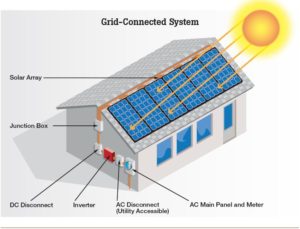 You have had a solar site assessment completed and you have completed your solar power business plan which should tell you whether it makes sense or not to go ahead with your installation. However there are two more major factor that should be included in your overall business plan. One is the subject of this post, Solar System management. The other is Solar System warranty program and maintenance. Which we will discuss in the next post.
You have had a solar site assessment completed and you have completed your solar power business plan which should tell you whether it makes sense or not to go ahead with your installation. However there are two more major factor that should be included in your overall business plan. One is the subject of this post, Solar System management. The other is Solar System warranty program and maintenance. Which we will discuss in the next post.
The system includes the panels on your roof and the inverters they are connected to. Of course the electrical system connection in your area. One of the most important elements in this system is measurement. It must measure the amount of electricity your system is consuming or providing to the network. All of these components must be managed on your behalf over the life of the contract that you have signed. Someone with the technical know how must deal with any problems that arise over the life of the system. Much like your car, which is very complex these days, you need a skilled technician to maintain it.
What is Solar System Management?
The first part of this is negotiating the rate that you will sell the electricity you generate back into the grid. It varies by location. Also the utility that you are dealing with. The rate per kilowatt is important as are the term of the contract and the rate that your initial rate will increase or decrease over the years. If you are signing a long term contract, then you want to make sure that your are protected for inflation. The rates will vary year over year. Of course each utility will have a different rate they will initially offer.
In addition in some areas, government subsidies play a large part in the economics of these installations. Some governments have also suddenly stopped providing these subsidies. Leaving the investors and owners with a loss based on the cost and the lower revenue. Potential investors should complete sensitivity studies. Take into account changes in the costs as well as changes in the revenue for both increases as well as decreases.
It is important to pay attention to this. Ensure you remain protected over the years of your contract.
Monitoring Your System
The second part of the solar system management activity is monitoring your system. It is important to understand that your system is running optimally at all times. Also when one component stops working or is not producing it’s optimum amount of electricity. If one component stops working, you want to know about it immediately. So that it can be corrected and not damage other components. As consumers we do not have the time to watch this and probably we would not understand what the system was telling us anyway.
Are there automated systems that report to the consumer. Or to the technical monitoring company when a system is not running optimally. How much does this cost? How reliable are the monitoring systems as well as the company that is providing the service.
Solar System Management contracts
This should be part of your contract with the company doing the installation so that it is worry free and trouble free. The last thing you want to be doing is your own monitoring! It is in your interest as well as your provider’s interest to ensure that the system is generating electricity and feeding it into the grid so that you both get paid over the life of the contract.
There will be literally hundreds of different contracts available across the continent. Consumers need to protect themselves by ensuring they actually read and understand these contracts. What are your responsibilities and what are the responsibilities of your provider?When you move, What do you need to do? What happens if the company you are dealing with goes bankrupt? What rates are you guaranteed? You probably want to have a lawyer review the contract. Specifically a lawyer who is familiar with solar systems and the peculiar idiosyncrasies of these contracts.
They are complex and it is worth taking the time to understand them! This is a complex project. Consumers should pay attention to this project in the same manner they would any other major project around their home.
For more posts about solar power business models, click here.